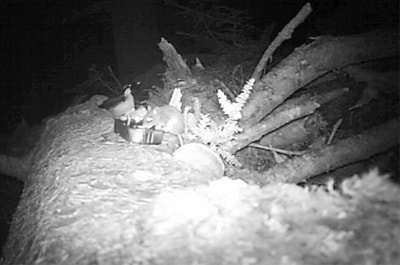Biologists have welcome news for seabirds in Englefield Bay.
Scattered with small islands, the west coast bay harbours a globally habitat for nesting seabirds such as ancient murrelets, Cassin’s auklets and Leach’s storm petrels.
From May to September, a team from the non-profit Bird Studies Canada posted motion-triggered night cameras on five Englefield Bay islands to see if raccoons, rats, or other invaders were preying on the birds.
“All the interesting seabirds came along and we didn’t find any raccoons, which is good news,” says Dr. David Bradley, the B.C. program manager for Bird Studies Canada.
Bradley said the night cameras did spot some mice, but they may be a native species.
Bradley cautioned that they cannot be 100 per cent sure the islands are free of raccoons without using hundreds more cameras, but said it’s unlikely.
He and colleague Karen Devitt also used a spotlight to search the islands shores for raccoons and found none.
On nearby Moresby Island, the same technique revealed dozens of racoons scavenging on the shoreline.
“Some of the islands are too far off the west coast to really be reachable by raccoons,” said Bradley, noting that the team chose the five islands — Lihou, Helgesen, Saunders, Carswell and Instructor — partly because earlier Canadian Wildlife Service studies showed their seabird colonies in decline.
The entire Englefield Bay area is also listed internationally as an Important Bird Area — one of 20 on Haida Gwaii.
Bradley said the work this summer is part of a three-year project to study the impact of invasive species on seabirds outside Gwaii Haanas, and the group has an Environment Canada grant for two more years.
“We’re trying to put some extra dollars on the table, because we understand that funding is always limited for work like this,” said Bradley.
The Bird Studies Canada research is supported by the Council of Haida Nation and BC Parks, and the team is also working closely with the Laskeek Bay Conservation Society.
